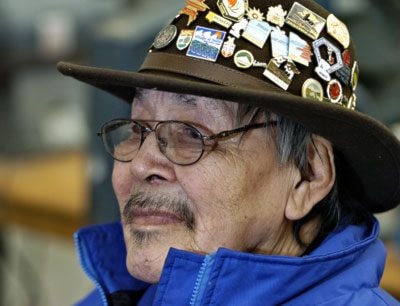Whitehorse knifemaker George Roberts and Inuit artist Simon Tookoome don’t have a lot in common.
The two men are from different lands thousands of kilometers apart.
One works in metal and bone, the other in pencil.
They don’t even speak the same language.
But the two men have been friends for years, exchanging metal-molding techniques for traditional knowledge about Inuit legends and lore.
“I have a special feeling inside when I’m around him,” says Roberts, while sitting in the ATCO Place tent on Friday afternoon.
“It’s very inspirational and I feel I have an inner tie to the Inuit people,” he adds, glancing over at his friend Tookoome sitting beside him.
The pair first met in Inuvik at the Great Northern Arts Festival nearly 10 years ago.
Since then they’ve kept in touch, meeting yearly at the festival and learning from each other.
Although the two artists speak different languages — Roberts speaks English and Tookoome speaks Inuktitut — they’re able to communicate through translators and hand gestures.
Over the years, they’ve shared their knowledge and developed a mutual respect for each other’s artwork.
Now the old friends are sitting side by side in the ATCO Place tent, demonstrating their art as part of the Canada Games cultural component.
“This is the first opportunity we’ve had to bring Simon to my home,” said Roberts.
Tookoome, a 72-year-old elder from Baker Lake, Nunavut, eschewed formal art training and learned to draw by watching others.
Today he uses coloured pencil to hand-draw images of history and legend.
“Family stories mostly,” says Tookoome through a translator.
“I make stories on the paper mostly about my past because there was lots of shamanism going on when I was young.”
“This is one of Simon’s favourite drawings,” explains Roberts while holding a long line drawing of beasts with human faces hidden in their bodies.
The image tells a story about how, at one time, people and animals were one and they lived together in an igloo.
One day one of the animals killed a human and so the animals were expelled from the igloo. Now the humans and the animals are separate, he explains.
Since the pair met, Tookoome has been interested in Roberts’ knives.
“They’re still used daily on the land where he’s from,” says Roberts.
“I’m happy George and I met because I love making the knives,” says Tookoome, through the translator.
“We use them out on the land — skinning caribou, cutting frozen meat — we use them daily.”
So far Tookoome has made five knives.
He arrived in Whitehorse a few days before the festival tent opened and spent some time working at Roberts’ shop in McCrae.
“He made another knife totally out of the memories he held from the workshops prior — I was very impressed,” says Roberts.
Learning is a two-way street with these friends.
“It’s a sharing thing — it’s all a circle,” says Roberts.
He has heard many traditional stories from Tookoome and has begun incorporating images from Inuit culture like inukshuks and drummers into his blades.
“The Inuit stone carvers taught me how to carve, so I carve in their flavour — that’s how I learned,” says Roberts.
When he carves an inukshuk he puts his own interpretation into the image.
Traditionally, an inukshuk is a marker on the land that shows travellers the way.
“When I chose to adapt it into my work, to me it still means ‘this way,’ but it also means ‘my way — from me to you,’” he explains.
“My artwork to you.”
Roberts began handcrafting knives out of necessity.
“I was a fishing guide in Northern Ontario in the late ‘70s when all the good knives disappeared.
“The offshore stuff started coming in and you couldn’t get a good knife anymore,” says Roberts.
So he began studying steel and accumulating knowledge on shaping blades and crafting handles.
He found the profession he was seeking for his entire life by accident.
Now Roberts has a small studio set up in the tent where he can transform a piece of steel into a work of art.
Ulus, long fishing knives, skinning knives and cutting knives sit in piles in his workshop.
He’s been in the business, which he dubs Bandit Blades, for nearly 30 years.
The nickname Bandit dates back to Roberts’ teenage years.
“I was into building racing cars and friends used to come and get their cars fixed and, instead of bringing me some money, they would bring a case of beer.
“Every time I came out from under the hood and there was a beer sitting there, I’d just grab it — and so the name ‘Bandit’ came.
“I’m sort of the beer thief that doesn’t drink beer anymore — that’s why I still have all my fingers, eh?” he adds with a laugh, gesturing towards the sharp blades in his makeshift shop.
Roberts is working on co-ordinating a trip to Tookoome’s home at Baker Lake — a small inland community of 1,500 near the geographical centre of Canada.
“You’ve got to be with the elders to go to another community because the elders know the way to go,” says Tookoome’s translator Jack Nuviyak, an emerging artist from Rankin Inlet.
Nuviyak is demonstrating his stenciling in the ATCO tent. He works with traditional images, like inukshuks and polar bears, and layers them to create mystical effects.
The artists will be demonstrating their skills and selling their art in the Shipyard Park tent until Wednesday.
